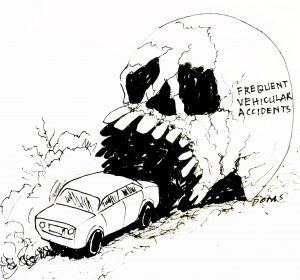Recent events have it that a number of vehicular accidents just happened, claiming lives as a result. Our local motorists should beware this rainy season because deadly road accidents often occur during the wet season due to a combination of factors that increase the risks on the roads.
First and foremost, the wet conditions significantly affect the friction between tires and the road surface, making it harder for vehicles to maintain a firm grip on the road. This reduced traction can lead to a loss of control, skidding, or hydroplaning, especially at higher speeds. Furthermore, heavy rains often impair visibility, reducing the ability of drivers to see obstacles, pedestrians, or other vehicles ahead. These factors, compounded by the potential for flash floods and damaged road infrastructure, result in a higher likelihood of fatal accidents during the wet season.
Moreover, the wet season conditions tend to increase driver errors and lapses in judgment. For instance, individuals commonly underestimate the impact of rainfall on driving conditions and fail to adapt their behavior accordingly. They might not reduce their speed or maintain additional distance from other vehicles, leading to a higher probability of collisions. Additionally, drivers may not be familiar with how to properly react in emergency situations, such as losing control on a wet road or encountering standing water. The lack of experience in handling such situations can be a key contributor to fatal accidents during the wet season.
Another factor that exacerbates road dangers is the presence of other road users who may not adhere to safety measures. Pedestrians and cyclists, for instance, might not use reflective gear or take extra precautions when walking or biking along roads in wet conditions. This increases the possibility of accidents, as drivers may struggle to see them in poor visibility. Motorists who prioritize speed and convenience over safety may engage in risky behavior, such as tailgating or abruptly changing lanes, amplifying the likelihood of fatal crashes.
To mitigate the occurrence of deadly road accidents, thorough public awareness campaigns should be in place. Educational programs should educate drivers and pedestrians about the specific dangers associated with wet conditions and disseminate appropriate safety precautions. Investing in improved road infrastructure, such as proper drainage systems and road maintenance, can also help reduce hazards caused by severe downpours. Local authorities should enforce traffic regulations more rigorously and impose stricter penalties for those who violate speed limits or engage in reckless driving behavior. By addressing these factors comprehensively, we can ensure safer roads and reduce the devastating consequences of deadly accidents.




